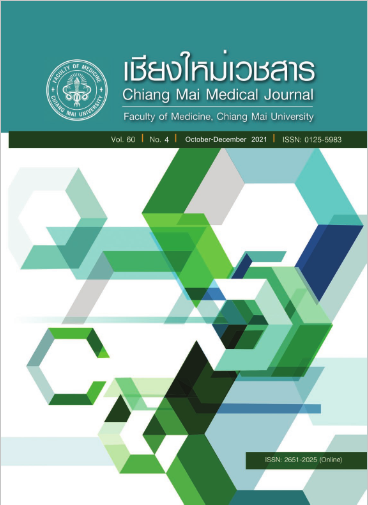Occupational health literacy among health workers in a hospital under the Bangkok Metropolitan Administration
Main Article Content
Abstract
Objectives To investigate occupational health literacy level and associated factors among health workers in a hospital under the Bangkok Metropolitan Administration.
Methods This research is a cross-sectional descriptive study. The samples, obtained from stratified sampling, were 415 health workers. Occupational health literacy was assessed by the self-administered questionnaire, The occupational health literacy scale for health workers, which has been adjusted and validated by content validity and reliability. Data were analyzed with descriptive statistics and multiple linear regression analysis.
Results The sample group had a moderate level of occupational health literacy with an average score 130.34 ± 15.79 (95%CI: 128.82-131.86) or 72.41 percent. The highest score was managing self-occupational health (74.53 percent) and the lowest score was occupational health communication skills (67.27 percent). Factors significantly associated with good occupational health literacy were female (p = 0.011), aged below 45 (p < 0.001), no shift work or overtime (p = 0.029), history of occupational health training (p = 0.002), occupational health and safety policy perception (p < 0.001) and adequate occupational health and safety support, by high support (p < 0.001) and low support (p = 0.023).
Conclusions The promotion of occupational health literacy among health workers should focus on occupational health communication skills, providing appropriated occupational health services to each group of occupation, increasing occupational health training, establishing occupational health and safety policy, and allocating support. To enable health workers to develop health workers’ competencies in occupational health practice for work safety and effectiveness.
Article Details

This work is licensed under a Creative Commons Attribution-NonCommercial-NoDerivatives 4.0 International License.
References
2. Nutbeam D. Defining, measuring and improving health literacy. HEP 2015;42(4):450-6.
3. Nutbeam D. The evolving concept of health literacy. Soc Sci Med 2008;67(12):2072-8.
4. Prime Minister's Office. The National reform plans B.E. 2561 (A.D. 2018). Royal Gazette 2018;135(Pt 24 k) dated 6 April B.E. 2018. (in Thai).
5. Ministry of public health. Health promotion and evaluation of health literacy and health behavior [Internet]. 2018 [cited 2021 Jan 14]. Available from: http://www.hed.go.th/linkhed/file/575. (in Thai).
6. Rauscher K.J, Myers D.J. Occupational health literacy and work-related injury among US adolescents. Int J Inj Contr Saf Promot 2014;21(1):81-9.
7. Tantranont K, Songkham W, Suthakorn W, Srisuphan W, Sakarinkul P, Dhatsuwan J. Development of a scale to measure occupational health and safety literacy scale among industrial workers. JRTAN. 2019;20(3):247-55. (in Thai).
8. Namthep W. Factors influencing of occupational health literacy among international migrant workers in Rayong province. Journal of public health nursing. 2018;32(3):115-32. (in Thai).
9. Kongsombatsuk M, Polyong C, Rittideah D. Occupational halth literacy affecting work-related disease and injury prevention behaviors among industrial workers. Journal of Medicine and Public Health, Ubon Ratchathani University 2020;3(2):112-20. (in Thai).
10. Polyong C, Rittideah D, Kongsombatsuk M, Praisuthisut K, Samanusron K. Validation of the occupational health literacy test for industrial workforce. Journal of safety and health 2020;13(2):140-57. (in Thai).
11. World Health Organization. Global atlas of the health workforce [Internet]. 2008 [cited 2021 Jan 18]. Available from: https://www.who.int/healthinfo/systems/WHO_MBHSS_2010_section2_web.pdf.
12. Taber KS. The use of Cronbach’s alpha when developing and reporting research instruments in science education. Res Sci Educ. 2018;48(6):1273-96.
13. Intarakamhang U. Final report of Creating and Developing of Thailand Health Literacy Scales [Internet]. 2017 [cited 2021 Jan 27]. Available from: http://bsris.swu.ac.th/upload/268335.pdf. (in Thai).
14. Lee HY, Lee J, Kim NK. Gender differences in health literacy among Korean adults: do women have a higher level of health literacy than men? Am J Mens Health 2015;9(5):370-9.
15. Von Wagner C, Knight K, Steptoe A, Wardle J. Functional health literacy and health-promoting behaviour in a national sample of British adults. J Epidemiol Community Health 2007;61(12):1086-90.
16. Caylan A, Yayla K, Oztora S, Dagdeviren HN. Assessing health literacy, the factors affecting it and their relation to some health behaviors among adults. Biomed Res-India 2017;28(15):6803-7.
17. Lippe E, Rattay P. Health-Risk Behaviour of Women and Men—Differences According to Partnership and Parenthood. Results of the German Health Update (GEDA) Survey 2009–2010. In: Doblhammer G, Guma J, editors. A demographic perspective on gender, family and health in Europe. Cham: Springer; 2018. p.233-61.
18. Yusida H, Suwandi T, Yusuf A, Sholihah Q. Relationship Individual Factors with Occupational Health Literacy (Observational Study on Industrial Workers of Sasirangan in South Kalimantan). IJSRP. 2017;6(1):481-4.
19. Sun X, Shi Y, Zeng Q, Wang Y, Du W, Wei N, et al. Determinants of health literacy and health behavior regarding infectious respiratory diseases: a pathway model. BMC public health 2013;13(1):261.
20. Siriruttanapruk S. Occupational health services for aging workers [Internet]. 2016 [cited 2021 Jun 7]. Available from: http://envocc.ddc.moph.go.th/uploads/ประชุม/24_08_59/8.1a.pptx. (in Thai).
21. Ekpanyaskul C. Workers and health In Principle of Occupational medicine for Preventive medicine & Public health. Bangkok: Jaransanitwong printing, 2018. p 1-38. (in Thai).
22 Çelikkalp Ü, Dilek F. Factors affecting the occupational accident rates among nurses. Rev Rsc Enferm USP 2019;53:1-8.
23. Sukpromson R. Incidence of work-related injury of professional nurses in Phayao hospital, Phayao. Nursing Journal of the Ministry of public Health 2560;27(3):107-19. (in Thai).
24. Matsee C, Waratwichit C. Promotion of health literacy: from concept to practice. Boromarajonani collage of nursing, Uttaradit journal 2560;9(2):96-110. (in Thai).
25. Chongchitpaisan W, Bandhukul A, Sithisarankul P. Occupational health practice for healthcare workers compared to hospital accreditation criteria in Thai governmental hospital, 2004. J Med Health Sci 2006;13(3):234-47. (in Thai).
26. Alli BO. Key principles in occupational health and safety. In: Alli BO. Fundamental principles of occupational health and safety. Second edition. Geneva: ILO; 2008. p.17-22.
27. Bandhukul A, Chongchitpaisan W. Occupational health service in hospital. In: Bandhukul A, editors. Textbook of occupational medicine. Bangkok: Department of Corrections press; 2011. p73-110. (in Thai).


